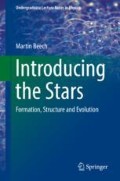Abstract
An outline of star formation was presented in Chap. 2. The key idea employed was that of gravitational collapse, with an extended gas cloud contracting to form a central protostar. Rotation of the initial gas cloud was also considered, and this results in the formation of an accretion disk about the protostar. Once all of the available cloud material has been incorporated into the protostar, it will continue to contract under gravity until the central temperature and density reach levels at which hydrogen fusion reactions can begin. Once the fusion reactions start within its central regions, the protostar will stop contracting and a bona fide main sequence star will have formed (as described in Chap. 4).
Access this chapter
Tax calculation will be finalised at checkout
Purchases are for personal use only
Notes
- 1.
This method uses observations of the Sun’s surface oscillation modes (caused by trapped sound waves) to constrain the variation of the density, pressure and temperature of its deep interior.
- 2.
The tacholine is the transition boundary between the Sun’s radiative interior and its convective envelope that occurs at a radius of about r = 0.7 R⊙. It marks the transition region whereby the solid-body-like rotation of the interior changes to the differential rotation exhibited in the Sun’s outer layers.
- 3.
This rather heavy-handed approach echoes (somewhat out of context) Eddington’s famous comment, ‘the mathematics is not there till we put it there’.
- 4.
Nothing, of course, lasts forever, but in principle a white dwarf can evolve to a temperature of absolute zero within its interior and still remain stable. The ultimate end fate for an aged white dwarf will be disruption and consumption by a massive black hole—a process that will take place in the very deep future of the universe.
- 5.
This characteristic value is based upon the observation that during a star’s most dramatic mass loss phase (as a bloated supergiant), the mass loss rate is of order 10−7 M⊙/yr and the luminosity is of order 5000 L⊙.
- 6.
This being said, analytic fitting formula can be obtained from the results of detailed stellar models. By far the most useful and comprehensive set of such analytic formulae is that found in the research paper by P. Eggleton, M. Fitchett and C. Tout. The distribution of visual binaries with two bright components. The Astrophysical Journal, 347, 998–1011 (1989) (and associated addenda).
- 7.
See Schröder and Smith, Distant future of the Sun and Earth revisited, Monthly Notices of the Royal Astronomical Society, 386, 155–163 (2008).
- 8.
See, P. Eggleton, J. Faulkner and R. Cannon. A small contribution to the giant problem. Monthly Notices of the Royal Astronomical Society, 298, 831–834 (1998).
- 9.
See, M. Beech, The Schönberg- Chandrasekhar limit: a polytropic approximation. Astrophysics and Space Science, 147, 219–227 (1988).
- 10.
The term white dwarf was apparently coined by Dutch astronomer Willem Luyten in 1922.
- 11.
The term black hole was coined in the 1960s and made particularly popular by physicist John Wheeler.
- 12.
In this case, the limiting mass applied to neutron stars—these objects are supported, up to another limiting mass, by the pressure of degenerate neutrons.
- 13.
Author Arthur C. Clarke has more famously written that ‘when a distinguished but elderly scientist states that something is possible, he is almost certainly right. When he states that something is impossible, he is very probably wrong’.
- 14.
This is a hypothetical state of matter that is thought to come about at extremely high densities and temperatures. In this state the quarks and gluons, which are normally confined inside atomic nuclei, can move about (at least for a very short time) as free particles.
- 15.
As to whether “forever” is really for all eternity or just a very, very long time is still open to debate.
- 16.
The classical radius for a black hole is identical to the more formally—and correctly—derived (via general relativity) Schwarzschild radius.
Author information
Authors and Affiliations
Rights and permissions
Copyright information
© 2019 Springer Nature Switzerland AG
About this chapter
Cite this chapter
Beech, M. (2019). The Ravages of Time. In: Introducing the Stars. Undergraduate Lecture Notes in Physics. Springer, Cham. https://doi.org/10.1007/978-3-030-11704-7_5
Download citation
DOI: https://doi.org/10.1007/978-3-030-11704-7_5
Published:
Publisher Name: Springer, Cham
Print ISBN: 978-3-030-11703-0
Online ISBN: 978-3-030-11704-7
eBook Packages: Physics and AstronomyPhysics and Astronomy (R0)

